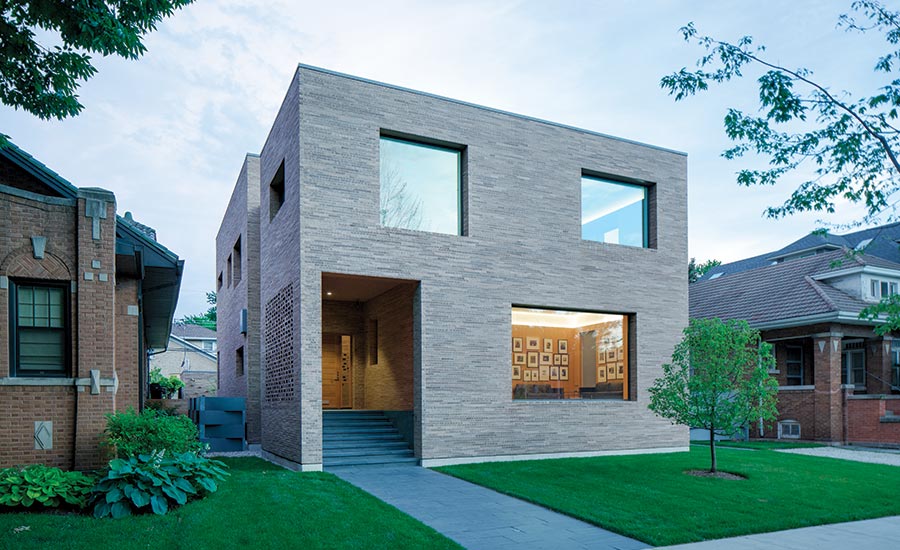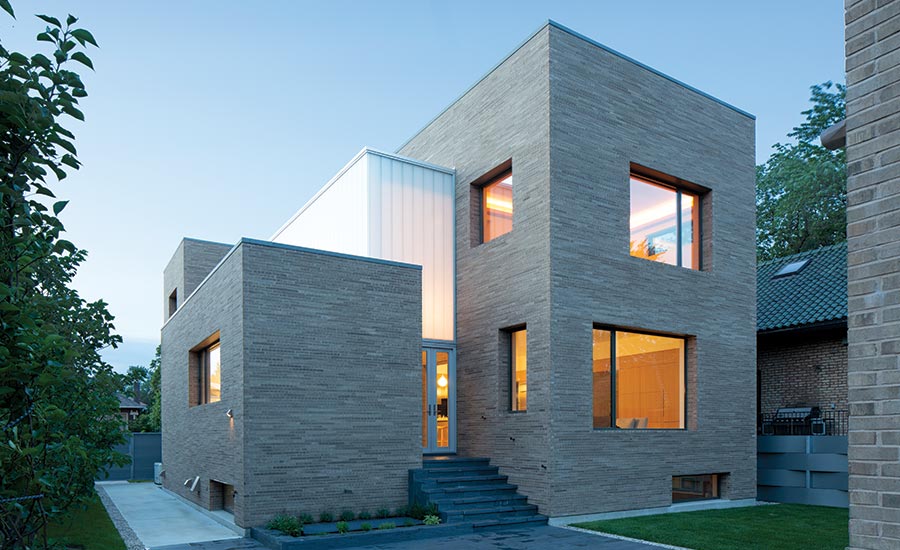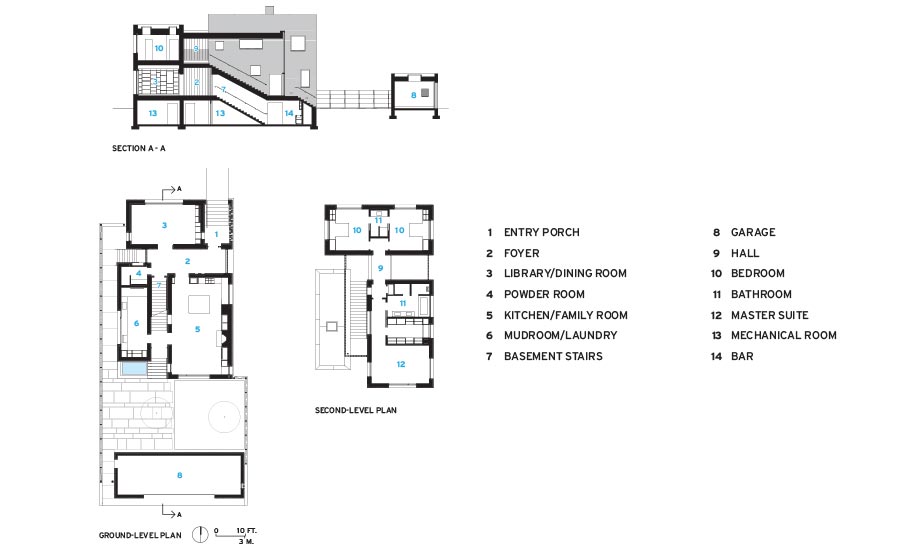Gallery House by John Ronan Architects
Chicago

Sitting squarely on its site, John Ronan’s house for a Chicago couple features elements that resonate with the neighborhood’s typology, such as the deep front porch and masonry structure.
Photo © Tony Armour

A rear view reveals the building’s unique massing of three volumes connected by glazed interstitial spaces.
Photo © Tony Armour

A second-floor bridge overlooks the foyer.
Photo © Tony Armour

The north-facing library/gallery has a large, fixed window with discreet shades to control daylight; small operable windows transfer east–west breezes. A Carl Hansen desk morphs into a dining table for entertaining.
Photo © Tony Armour

A modular photo-hanging system by Ronan allows the owner to easily rearrange the wall display.
Photo © Tony Armour

The kitchen/family room provides gathering spaces, with its large marble island and brick fireplace.
Photo © Tony Armour

The kitchen/family room provides gathering spaces, with its large marble island and brick fireplace.
Photo © Tony Armour

Operable windows above the beds in the children’s bedrooms transfer breezes.
Photo © Tony Armour

One of the husband’s favorite places, the generous 5½-foot-wide back staircase and upper landing encourages hanging out. Deep apertures in the brick wall frame snapshot views into adjacent areas.
Photo © Tony Armour

Image courtesy John Ronan Architects










Architects & Firms
Ravenswood Manor, a gentrifying neighborhood on the North Side of Chicago, is notable for its tree-lined streets and eclectic mix of early 20th-century and prewar single-family and multiunit dwellings, including many bunga- lows and foursquare houses. Listed on the National Register of Historic Places, it is not an easy place to build a new residence. So when a local couple tore down their Craftsman style stucco house (circa 1910) to build a new one, it was not without controversy. Yet, while some maintain the community “legacy” should have been saved, the substantial, pale brick house that replaced it, designed by local architect John Ronan, speaks to its surroundings with a common materiality, geometry, and scale that is neither slavish nor disrespectful to the area’s typology.
Additional Content:
Jump to credits & specifications
The homeowners—recent empty-nesters who had lived on the property since 1993 and raised their two children there—loved the neighborhood for its proximity to downtown and public transit, as well as the growing influx of young families, shops, and restaurants. But their existing 100-year-old residence was dark, carved up, and problematic; it had also been rehabbed four times over the years. They ultimately chose to demolish it when they couldn’t find a similar location to build a new house that would better suit them. “Additionally,” says the husband, “we have a 50-foot-wide lot, which means we’re land barons, in Chicago terms.”
Ronan, known for such thoughtful urban and institutional works as the Illinois Institute of Technology’s Ed Kaplan Family Institute for Innovation and Tech Entrepreneurship and the Poetry Foundation in Chicago, was also attracted to the expansive 6,250-square-foot site, not least for the opportunities it would provide to bring sunlight into a building. The couple wanted a light-filled home to showcase a collection of vintage black-and-white photographs the husband, a commercial photographer, has been accumulating. In addition to that, their brief to the architect simply stipulated a brick house with a great kitchen. “We didn’t want to put any constraints on anything, except for those three things,” says the wife, who works in investment management, often from home. “We wanted him to push us to make a great house.”
In keeping with the language and density of the neighborhood, the 5,600-square-foot, two-story residence fills the site comfortably without overcrowding it. Like many of the surrounding properties, the house is made of brick, has a basement and deep front-entry porch, and is flanked by small but gracious front and back yards with a separate brick garage facing an alley behind it. This is largely where the similarities fade, however. The clients, who like to entertain, were never satisfied with the spatial constraints and poor flow of their old house. At the same time, they didn’t really want an open plan for the new one. Ronan responded with a unique hybrid, creating a house that comprises three distinct volumes, each a skylit, load-bearing masonry structure that defines a particular set of flexible programs. The first volume spans the front of the house on its north side and contains a library/ dining room on the first floor, with two bedrooms for visiting children or guests and shared bath above; directly behind it, to the southeast, the largest structure houses a spacious kitchen/family room, topped by the second-floor master suite; and, to the southwest, a slender, single-story volume serves as the family’s mudroom and laundry wing. These are massed around wide, double-height interstitial spaces enclosed by each structure’s walls and insulated channel glass.
The resulting interior is welcoming, luminous, and surprising, warmed throughout by hydronic radiant-floor heat and permeated by a gentle, diffuse daylight, friendly to both photographs and people. Generous doorways between spaces connect them visually and enhance circulation. Ronan paid particular attention to the in-between places, making them as important and useful as larger rooms. An 8-foot-wide foyer, for instance, is more gallery than corridor, and can also double as a dining area. Five-and-one-half-foot-wide stairways that lead up to the second floor and down to a 2,150-square-foot basement (housing a home office, guest suite, and mechanicals) are commodious enough for moving things around the house, when necessary, or sitting down for a chat—as in the roomy landing on the upper level, where an adjacent bridge to the bedrooms overlooks the voluminous entrance.
“This house is all about proportion and materials,” says Ronan. “We wanted a reduced and neutral palette as a backdrop for the photography collection.” This decision led to the selection of textured champagne-hued brick from Iowa, white oak for custom millwork (sourced from a single tree), and floor planks made from the same species for the kitchen and library floors, stairs, and upper landing. Flinty Vermont-slate tile marries outdoor and indoor spaces as paving for the path from the street, front and back entrance halls, and backyard.
Ronan’s attention to detail and craft is apparent in all aspects of the project, from the random bond pattern of the unique 24-by-4-by-15⁄16-inch brick to the deep-set steel windows, solid white oak front door, and the home’s bronze handrails and curving zinc fence (which matches the coping used around the house and garage). He even collaborated with the husband to devise a clever modular photo-hanging system for the library wall panels. Whenever possible, the scheme affords opportunities for natural light and ventilation. Apertures in the thick brick wall along the back stair and operable windows in every room frame views and transfer breezes, while a pierced, screen-like section in the masonry facade filters light and air into and from the porch. In the evening, a warm glow radiates through the porous wall and down the stairs, a gentle complement to the lantern-like effect of the building’s translucent glass.
According to the clients, they occupy every part of the house—especially the kitchen/family room, where there is a well-used fireplace and a 6-by-7-foot marble island that they typically dine at or gather around with friends and family. They love the home’s functionality and its generosity of space and light. “And,” says the husband, “it’s no bigger than our old house.” At 3,426 square feet above grade, the new building’s street presence remains within the limits of its predecessor, which was 3,500 square feet. “In terms of scale, the house fits in with everything in the neighborhood,” says Ronan, “but it’s a house of its own time.”
CreditsArchitect: John Ronan Architects — John Ronan, principal, lead designer; Sam Park, Andrew Akins, Brett Gustafson, Laura Gomez Hernandez, project team
Engineers: Stearn-Joglekar (structural); AA Service (mechanical)
General contractor: Fraser Construction |
SpecificationsMasonry Sioux City Brick
Glazing Pilkington (windows); Bendheim (channel glass)
Steel frames Hope’s Windows
Doors Fleetwood (entrance)
Hardware FSB; DORMA
Millwork KWI Cabinetry
Slate Vermont Structural Slate
Lighting Flos; Louis Poulsen; Luminii; Kichler;
Controls Lutron
Radiant floor heating Warmboard
Plumbing Vola; Kohler; Toto; Franke; Duravit; D-Line |














